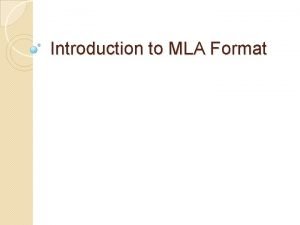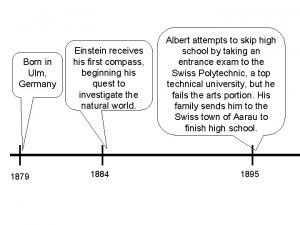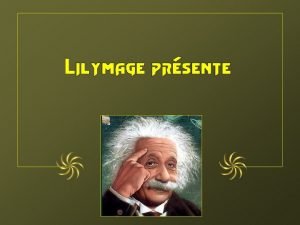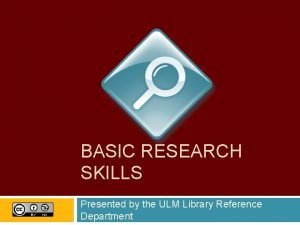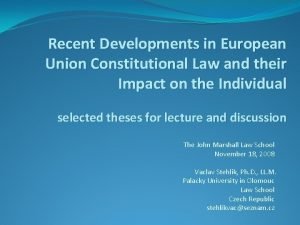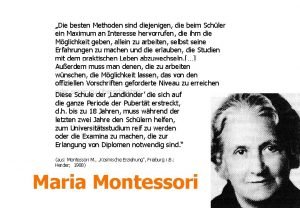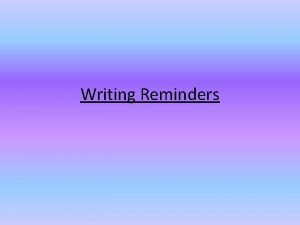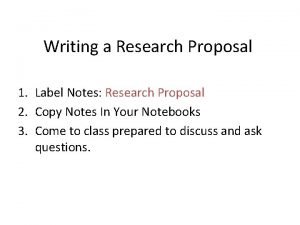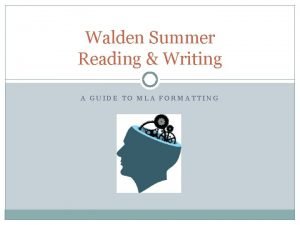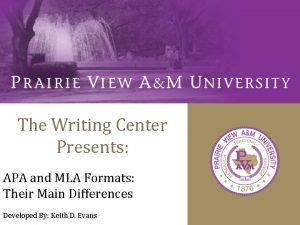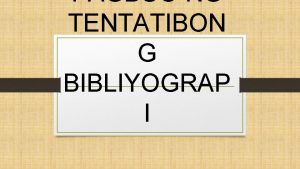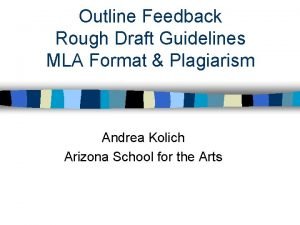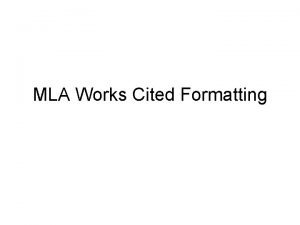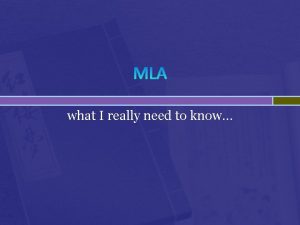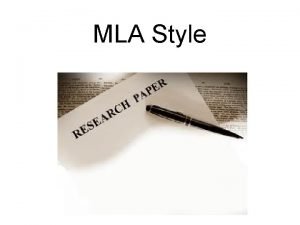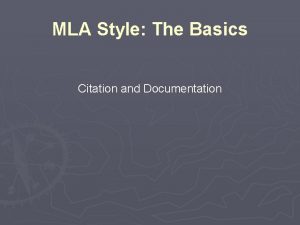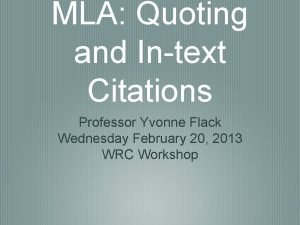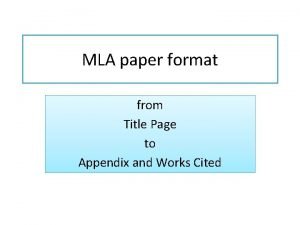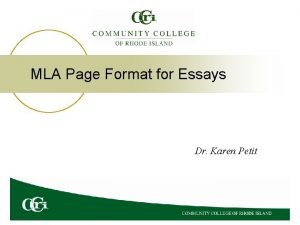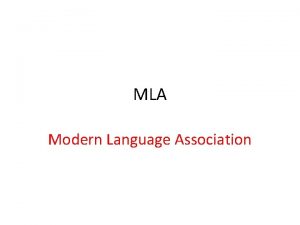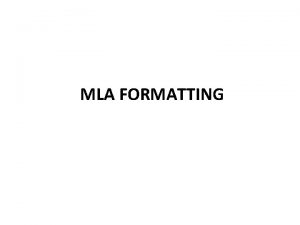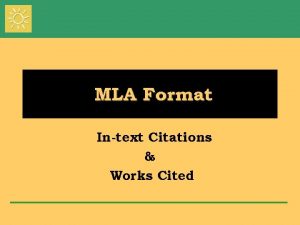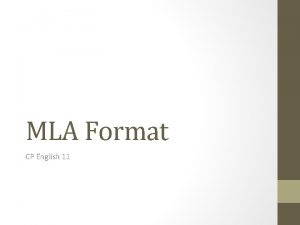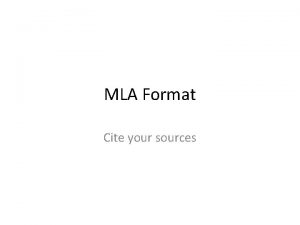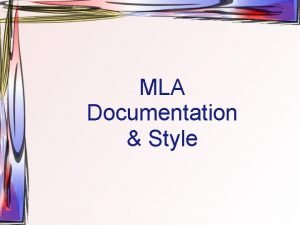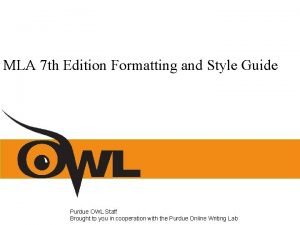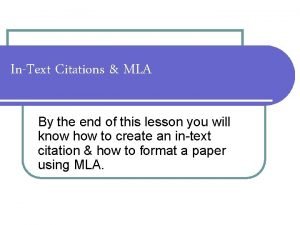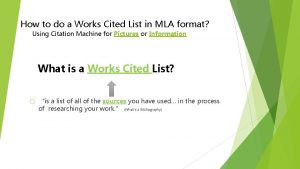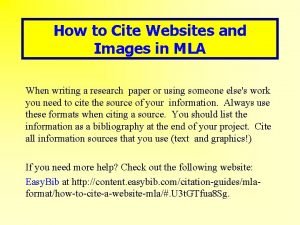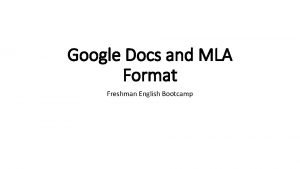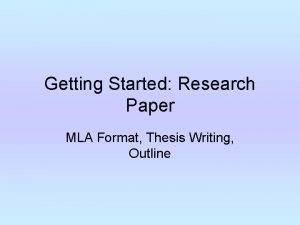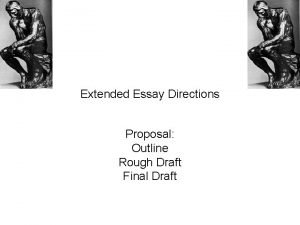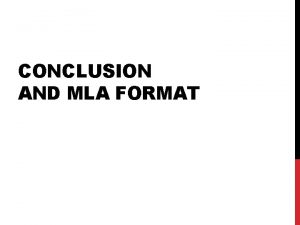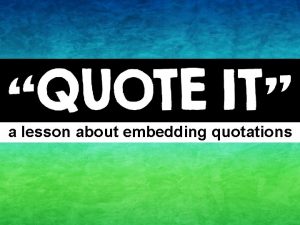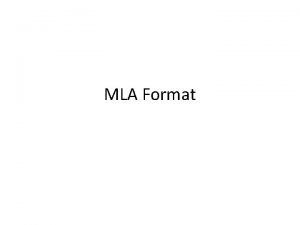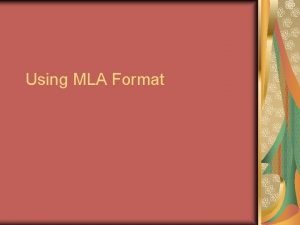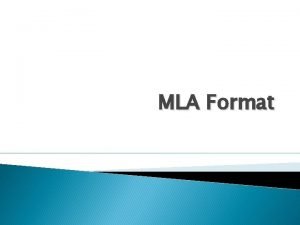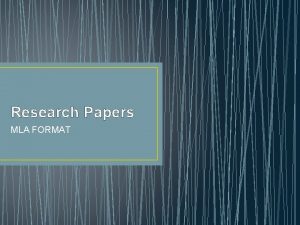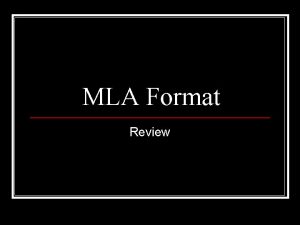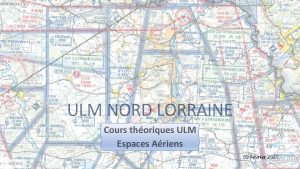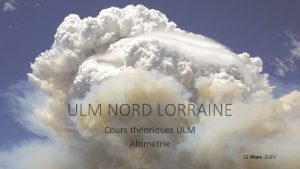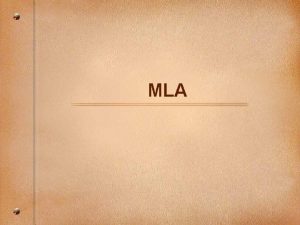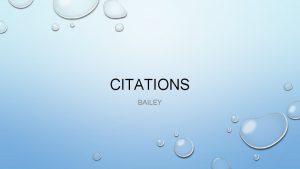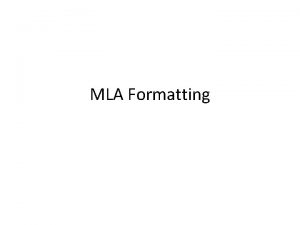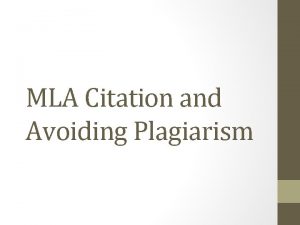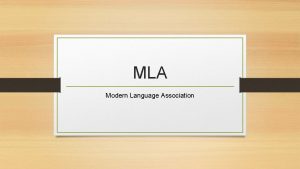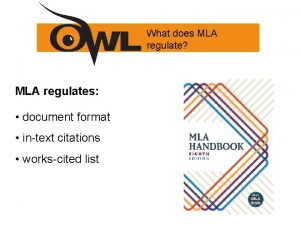Introduction to MLA Format Reference Department at ULM






















































- Slides: 54

Introduction to MLA Format Reference Department at ULM Library

Session Overview What is MLA Format? Why Do We Use MLA? General Guidelines Quotes/Paraphrasing In-Text Citations Works Cited Resources Any Questions?

What is MLA Format? MLA Format is a system of documenting sources that was authored by the Modern Language Association This format is used for documenting sources in disciplines such as English and the Humanities

Why Do We Use MLA? Academic writers write for their peers and write in academic journals, books, novels, etc MLA allows you as a writer to give credit to authors for using their work or ideas in your research paper We also use MLA so when we document these sources in our research papers, the sources will be formatted in a standardized way

So You Will Use It To…. Format your paper, including… Margins Spacing Font selection and size Headers/footers Guide the style Quotations In-text citations Voice of your paper, including…

General Guidelines 1 inch margin on all pages Double Use space each line 12 point for the font size a professional font type such as Times New Roman and be consistent

General Guidelines Page headers Include page numbers and author’s name May be omitted from first page Only one space following ending punctuation of sentences Indent first sentence of paragraphs ½ inch from margin – MLA recommends simply using the Tab key (versus spacing over manually) Use an active voice whenever possible

General Guidelines MLA papers don’t typically need cover pages – so unless your professor asks for one, it’s not necessary to create one MLA papers do need a heading in which you list your name, your professor’s name, the class, and the date – this is typically double-spaced

Guidelines First Page Format your papers

Guidelines First Page Examples of titles within titles: The Function of Time in Woolf’s To the Lighthouse Sexuality in Faulkner’s “A Rose for Emily” Race and Race Relations in Baraka’s “Dutchman”

Quotations/Paraphrasing When you’re writing a research paper, you’re going to have to work other people’s research into your own, in order to: Demonstrate the validity of your point of view Inform your audience of what research has been done on the topic Show your audience how your point of view fits into what’s been done

Quotations/Paraphrasing There are two ways of incorporating information into your paper – quoting and paraphrasing MLA has guidelines for how to use quotations and paraphrasing in your writing It’s important to understand how these two methods differ

Quotations are the actual words taken from the text, word for word, as they appear in the text itself Quotations can be high impact – the words of an expert that support your argument carry a lot of weight

Quotations and Quoting But including too many quotations is lazy; you’re letting the research do all of the work Sometimes too many quotations looks like plagiarism – you’re using someone else’s ideas as your arguments, rather than as support *You* are supposed to be doing the work; quotations are just tools with which to do the work

Quotations and Quoting There are two ways to quote: 1 st way- Direct Quotations use the author’s name as part of the sentence. Examples: Dickens said, “it was the best of times, it was the worst of times. ” According to Dickens, “it was the best of times, it was the worst of times. ”

Quotations and Quoting Direction quotations do not allow for change – a direct quotation is, word for word, identical to the way it appears in the original text The original text MUST HAVE QUOTATION MARKS around it Examples: Dickens said, “it was the best of times, it was the worst of times” (62). According to Dickens, “it was the best of times, it was the worst of times” (62). The quotation marks show where the author’s words begin and end, distinguishing them from YOUR writing.

Quotes and Quotations 2 nd way: indirect quotations - DO NOT include the author or authors’ names in the sentence But you still have to use quotation marks, and you can’t make changes to the text Not the author’s name Some researchers note that "children are totally insensitive to their parents' shyness" (Zimbardo 62). So it’s got to be here

Paraphrasing A second way you can incorporate information into your writing is to paraphrase Paraphrasing is the act of taking information from a text and either Summarizing it – taking a whole paragraph’s worth of information and boiling it down to a few sentences, or Rewording it - demonstrating your understanding of the information by putting it into your own words, in such a way that is significantly different from the original text

Paraphasing Summary The paragraph you’re about to see is very long, too long to quote effectively One of your options is to summarize the paragraph in your own words, reducing and simplifying Remember, though, you’ll still have to do an in-text citation (more on that in a minute) Summaries do not require quotation marks

Paraphrasing Summary ORIGINAL TEXT – TOO LONG TO QUOTE Children are totally insensitive to their parents' shyness; it is SUMMARY ORIGINAL TEXT EASIER TO USE the rare child who. OF labels a parent shy –[. . . ] This is understandable, since parents are in positions of control and Because parents areand authority figures the home, authority in their homes may not revealintheir shy side to notsince immediately of theirchildren. are Also, shynessaware is viewed as undesirable parents’ shyness; it may be too scary theof parents in by many children, it may be threatening to for think children of their parents in negative terms. as these terms. to At think this young age, the parent is still idealized all-knowing and all-powerful - - not dumb, ugly, or weak. Zimbardo, Philip G. Shyness: What It Is, What to Do About It. Perseus Books, 1977.

Paraphrasing: Rewording If you aren’t concerned with the length of a section, or you feel you can’t boil the information down without losing something important, you have the option of putting the information in your own words Make sure the info really is in your own words – if it’s too close to the original text, it could be considered plagiarism

Paraphrasing: Rewording The result of paraphrasing a paragraph may produce a paragraph of equal length, and that’s okay What’s important is that the information is actually in your own words and That you give credit where credit is due Let’s take a look at an example of rewording paraphrasing, shall we?

Paraphrasing: Rewording ORIGINAL TEXT, AS IS REWORDED/PARAPHRASE Children are totally to perceived their parents' it is A parent’s shynessinsensitive is not often by ashyness; child, and therarely rare child labels a parent shy [. . . ] is shy. wouldwho a child describe a parent as This being understandable, since arefigures in positions control Because parents are parents authority in the of home, thatand authority their and may not reveal theirbehave shy side to shynessin may nothomes manifest, nor may the parent their children. Also, of since is viewed shyness as undesirable by bashfully in front the shyness child. Moreover, is many children, it may be threatening tochildren, think of parents often valued in a negative fashion by so to in these terms. At this in young age, thecan parent is still idealized think of a parent this fashion be unsettling to the as all-knowing all-powerful not dumb, ugly, or of weak. child. Theand child idolizes the- -parent at this stage development. Zimbardo, Philip G. Shyness: What It Is, What to Do About It. Perseus Books, 1977.

Quoting versus Paraphrasing: When? Both of these methods of using resources in your writing have many benefits – so how do you decide when to use which? Remember: quoting is usually high impact – it’s good for emphasis, when you think taking the words out of the horse’s mouth is the best means of persuasion Quoting is like a punch: your opponent CANNOT ignore it!

Quoting versus Paraphrasing: When? Paraphrasing is better for condensing a lot of information into a more manageable amount (like we saw in the summary example) It’s also very useful when the information is very technical or the author’s style is very dry and inaccessible – you can make the info more easy to consume for your audience You can also combine authors’ ideas that are similar into one passage through paraphrasing

Paraphrasing: More on Combining Ideas Let’s say you have two authors who say similar things on a topic. Zimbardo writes: Children are totally insensitive to their parents' shyness. Smith writes: Children are usually unaware when their parents are shy.

Paraphrasing: More on Combining Ideas These two passages of information can be blended together (mmmm…. info smoothie) to keep your information concise and to prevent unnecessary repetition. So, a paraphrase of their information blended together would look like this: Some researchers note that children are often ignorant with regard to their parents’ shyness (Zimbardo 62; Smith 45).

Incorporating Info Into Your Own Writing It’s NOT recommended that you just put quotations in your writing without some kind of preamble or introduction or explanation A good rule of thumb is that every sentence in your writing should contain something you wrote, no matter what Transitions are important, particularly between your writing and thoughts, and the quotations

Incorporating Quotations into Your Writing And it’s not necessary for every quotation to end the sentence – let’s look at the variants on the Zimbardo quotations again. Zimbardo notes that “children are totally insensitive to their parents’ shyness” (62), though some authors disagree. Some researchers note that "children are totally insensitive to their parents' shyness" (Zimbardo 62), but other authors disagree.

In-text Citations When using someone else’s work in your own – whether you’re quoting or paraphrasing – you’ll need to give credit where credit is due, or document what isn’t your work This is where in-text citations come in – you’ve seen a few already, but we’ll look at them more closely now

In-text Citations � These are used to cite resources within the text � Every in-text citation should have a corresponding citation in the Works Cited section � If you quote something directly from a text, then the citation will include the author or authors’ names and page number

In-text Citations Direct quotation, author named in sentence According to Jones, "Students often had difficulty using APA style, especially when it was their first time" (199).

In-text Citations, Continued Direct quotation, author not named in sentence According to some researchers, "Students often had difficulty using APA style, especially when it was their first time" (Jones 199). Please note: the period doesn’t come until AFTER the in-text citation. The sentence isn’t complete until the citation is complete.

In-text Citations, Continued � Long quotations (more than four lines) should be set apart (that is, not within the text, but in a block quotation) � Omit quotation marks � Indent 1 inch (2 hits to the Tab key) from margin � Maintain double spacing � Same rules apply for in-text citation, EXCEPT that the quotation will end with its punctuation, then followed by the citation

In-text Citations, Continued Long direct quotation One study found the following: Students often had difficulty using APA style, especially when it was their first time citing sources. This difficulty could be attributed to the fact that many students failed to purchase a style manual or to ask their teacher for help. (Jones 199)

In-text Citations, Continued � Even if you’re paraphrasing something, you’ll still need to identify the original source � In-text � The citations work for paraphrasing, too in-text citations will include the author’s name and page numbers, if available; remember, if the author is unknown, use an abbreviated version of the title

In-text Citations, Continued Paraphrasing in-text citations According to Jones, APA style is a difficult citation format for first-time learners (199). APA style is a difficult citation format for first-time learners (Jones 199). MLA uses an author-page format in in-text citations (“MLA In -Text Citations”).

Works Cited The Works Cited page lists the resources you used in your paper – this is where you document those sources Remember: if you have an in-text citation, you will have a corresponding bibliographic citation in your references References are double-spaced, too

Works Cited, Continued � On the Works Cited page: center the title “Works Cited” (without quotation marks) at the top of the page � All lines following the first line of the citation will be indented a one half-inch from the margin (also known as a hanging indent) � Italicize titles of long works, like books or journal titles � Put quotation marks around the titles of short works, like essays or articles

Works Cited, Continued Author names are inverted; that is, last name first In resources with more than one author, all other authors’ names are first name first, last name last If a source does not have an author, it will be alphabetized based on title

Works Cited, Continued The core elements of any works cited entry are given below in the order in which they should appear; Not all entries will have all of these 1. Author. 2. Title of source. 3. Title of container, 4. Other contributors, 5. Version, 6. Number, 7. Publisher, 8. Publication date, 9. Location.

Works Cited, How to Cite Authors The author’s name is usually displayed in a work near the title Begin the entry with the author’s last name, followed by a comma and the rest of the author’s name End this element with a period Examples: Jacobs, Alan. The Pleasures of Reading in an Age of Distraction. Oxford UP, 2011. Doris, Michael, and Louise Erdich. The Crown of Columbus. Harper. Collins Publishers, 1999. Burdick, Anne, et. al. Digital Humanities. MIT P, 2012.

Works Cited, How to Cite Titles of Sources After the author, the next element included in a works cited entry is the title of the source The title is often displayed in a work near the author Italicize larger works like books and collections of essays or poems Example: Puig, Manuel. Kiss of the Spider Woman. Translated by Thomas Colchie, Vintage Books, 1991. Put quotation marks around shorter works such as titles of article names, essays, stories, or poems Example: Goldman, Anne. “Questions of Transport: Reading Primo Levi Reading Dante. ” The Georgia Review, vol. 64, no 1, 2010, pp. 69 -88.

Works Cited, How to Cite Titles of Container When the source being documented forms a part of a larger whole, (like a book that is a collection of essays) the larger whole can be thought of as a container The title of the container is usually italicized and followed by a comma, since the information that comes next describes the container Examples: Journal is made up of articles Williams, Joy. “Rogue Territory. ” The New York Times Book Review, 9 Nov. 2014, pp. 1+. Television series is made up of episodes “Hush. ” Buffy the Vampire Slayer, created by Joss Whedon, performance by Sarah Michelle Gellar, season 4, episode 10, Mutant Enemy, 1999.

Works Cited, How to Cite Other Contributors Aside from an author whose name appears at the start of an entry, other people may be credited in the source as contributors, and you note this if their participation is important to your research or to the identification of the work Common descriptors are: adapted by, directed by, edited by, illustrated by, introduction by, narrated by, performance by, and translated by Example: “Hush. ” Buffy the Vampire Slayer, created by Joss Whedon, performance by Sarah Michelle Gellar, season 4, episode 10, Mutant Enemy, 1999.

Works Cited, How to Cite Versions If a source carries a notation indicating it is a version of an edition of a work released in more than one form, you may want to identify the version in your entry Examples: The Bible. Authorized King James Version, Oxford UP, 1998. Newcomb. Horace, editor. Television: The Critical View. 7 th ed. , Oxford UP, 2007. Scott Ridley, director. Blade Runner. 1982. Performance by Harrison Ford, director’s cut, Warner Bros. , 1992.

Works Cited, How to Cite Number If the source you are citing is part of a numbered sequence, you may want to document that Examples: Multiple volume set Rampersand, Arnold. The Life of Langston Hughes. 2 nd ed. , vol. 2, Oxford UP, 2002. Journal Issues, which include volume and issue numbers Baron, Naomi S. “Redefining Reading: The Impact of Digital Communication Media. ” PMLA, vol. 128, no. 1, Jan. 2013, pp. 193 -200.

Works Cited, How to Cite Publisher The publisher is the organization responsible for producing the source or making it available to the public If more than one publisher is listed and they seem equally responsible, list each and separate the names with a slash (/) Example: Jacobs, Alan. The Pleasures of Reading in an Age of Distraction. Oxford UP, 2011. Another Tip: For Websites published by organizations, including museums, libraries, and universities, the publisher can be found in the “about us” or copyright information

Works Cited, How to Cite Publisher Continued A publishers name may be omitted for: Periodials/Journals Works published by authors or editors A website whose title is essentially the same as the name of its publisher A website not involved in producing the works it makes available such as Youtube

Works Cited, How to Cite: Publication Date Sources– especially those published online– may be associated with more than one publication date or may just have one date to document When a source carries more than one date, use the date most relevant to your use of the source Examples: For an article on the website of a news organization Deresiewicz, William. “The Death of the Artist—and the Birth of the Creative Entrepreneur. ” The Atlantic, 28 Dec. 2014, www. theatlantic. com/archive/2015/01/the-death-of-the-artist-and-thebirth-of-the-creative-entrepreneur/383497/. Book Rampersand, Arnold. The Life of Langston Hughes. 2 nd ed. , vol. 2, Oxford UP, 2002.

Works Cited, How to Cite: Location How to specify the work’s location depends on the medium of publication Examples: Print sources (uses a range of page numbers) Goldman, Anne. “Questions of Transport: Reading Primo Levi Reading Dante. ” The Georgia Review, vol. 64, no 1, 2010, pp. 69 -88. Websites (uses URL) Deresiewicz, William. “The Death of the Artist—and the Birth of the Creative Entrepreneur. ” The Atlantic, 28 Dec. 2014, www. theatlantic. com/archive/2015/01/the-death-of-the-artist-and-thebirth-of-the-creative-entrepreneur/383497/. Physical Objects Bearden, Romare. The Train. 1975, Museum of Modern Art, New York.

MLA Resources The Online Writing Lab (OWL) at Purdue: MLA http: //owl. english. purdue. edu/owl/resource/747/01/ Son of Citation Machine: Citation Generator http: //citationmachine. net/ Easy. Bib: Free Automatic Bibliography & Citation Maker http: //www. easybib. com/

Q & A Time

Thanks for your attendance! Remember, if you need research help, all you have to do is ask the librarians. You can… q Visit the Reference Desk, Library 1 st floor q Email us at reference@ulm. edu q Call us at (318) 342 -1071
 Parenthetical example
Parenthetical example Ulm albert
Ulm albert Peter langer ulm
Peter langer ulm Peter langer ulm
Peter langer ulm Ulm germany 1879
Ulm germany 1879 Ulm 1879
Ulm 1879 Ulm nursing faculty
Ulm nursing faculty Ulm albert
Ulm albert Bildungsmesse ulm aussteller
Bildungsmesse ulm aussteller Rainer kurz
Rainer kurz Hkw ulm
Hkw ulm Ulm library database
Ulm library database Wieland bkk ulm
Wieland bkk ulm Parker hannifin new ulm mn
Parker hannifin new ulm mn Uni ulm master wiwi
Uni ulm master wiwi Stauder v city of ulm summary
Stauder v city of ulm summary Montessori schule neu ulm
Montessori schule neu ulm Wertkettenanalyse krankenhaus
Wertkettenanalyse krankenhaus Reference node and non reference node
Reference node and non reference node Reference node and non reference node
Reference node and non reference node Mla left hand corner
Mla left hand corner Introduction of research proposal
Introduction of research proposal Mla format handwritten
Mla format handwritten Mla format specifications
Mla format specifications Apa cover page format
Apa cover page format Saan ilalagay ang bibliograpiya
Saan ilalagay ang bibliograpiya Rough draft mla format
Rough draft mla format Owl mla works cited
Owl mla works cited Mla heading
Mla heading Binti mla citation
Binti mla citation Mla cover page format
Mla cover page format Quoting poetry in mla
Quoting poetry in mla Annotated bibliography ppt
Annotated bibliography ppt How to do appendices
How to do appendices 1 inch margin
1 inch margin Mla prefers times new roman font.
Mla prefers times new roman font. Paragraphs in mla format
Paragraphs in mla format Mla works cited page
Mla works cited page Whats works cited
Whats works cited Works cited page mla example
Works cited page mla example English citations
English citations How to cite a source mla
How to cite a source mla Formal header
Formal header Works cited page example
Works cited page example Email memo
Email memo Formal complimentary close
Formal complimentary close Mla intext citations
Mla intext citations How to do a works cited page
How to do a works cited page How to cite an image in mla
How to cite an image in mla How to do mla header on google docs
How to do mla header on google docs Preliminary outline example
Preliminary outline example Mla format rough draft
Mla format rough draft How to restate your thesis example
How to restate your thesis example Bibliography cards definition
Bibliography cards definition Embedding quotes sentence starters
Embedding quotes sentence starters
